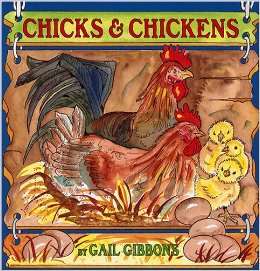From Chicken Little to Chicken Big (Grades 3-5)
Students identify different breeds of chickens, examine physical characteristics, and determine the stages of a chicken's life cycle.

Background
Lesson Activities
Recommended Companion Resources
Credits
Author
Darlene Petranick and Michele Reedy | North Carolina Farm Bureau Ag in the Classroom
Standards
Indiana Content Area Standards
-
English Language Arts.Grade 3.RN.1
Read and comprehend a variety of nonfiction within a range of complexity appropriate for grades 2-3. By the end of grade 3, students interact with texts proficiently and independently.
- Key Idea and Textual Support.3.RN.2.3: Describe the relationship between a series of historical events, scientific ideas or concepts, or steps in processes or procedures in a text, using words such as first, next, finally, because, problem, solution, same, and different.
- Key Ideas and Textual Support.3.RN.2.1: Ask and answer questions to demonstrate understanding of a text, referring explicitly to the text as the basis for the answers.
- Structural Elements and Organization.3.RN.3.1: Apply knowledge of text features to locate information and gain meaning from a text (e.g., maps, illustrations, charts, font/format).
-
English Language Arts.Grade 3.RV.1
Build and use accurately conversational, general academic, and content-specific words and phrases.
- Vocabulary in Literature and Nonfiction Texts.3.RV.3.2: Determine the meanings of general academic and content-specific words and phrases in a nonfiction text relevant to a third grade topic or subject area.
-
English Language Arts.Grade 3.W.1
Write routinely over a variety of time frames and for a range of discipline-specific tasks, purposes, and audiences; apply reading standards to write in response to literature and nonfiction texts.
- Conventions of Standard English.3.W.6.1: Demonstrate command of English grammar and usage, focusing on: 3.W.6.1a Nouns/Pronouns Writing sentences using abstract nouns (e.g., hope, thought). 3.W.6.1b Verbs Writing sentences that use regular and irregular verbs and simple verb tenses to convey various times, sequences, states, and conditions. 3.W.6.1c Adjectives/ Adverbs Writing sentences that include comparative and superlative adjectives and adverbs, choosing between them depending on what is to be modified, and explaining their functions in the sentence. 3.W.6.1e Usage Writing correctly complete simple, compound, and complex declarative, interrogative, imperative, and exclamatory sentences, using coordinating and subordinating conjunctions (e.g., and, for, but, or).
- Conventions of Standard English.3.W.6.2: Demonstrate command of capitalization, punctuation, and spelling, focusing on: 3.W.6.2a Capitalization Capitalizing appropriate words in titles, historical periods, company names, product names, and special events. 3.W.6.2b Punctuation a. Correctly using apostrophes to form contractions and singular and plural possessives. b. Using quotation marks to mark direct speech. c. Using commas in locations and addresses; to mark direct speech; and for coordinating adjectives (e.g., a small, red bicycle). 3.W.6.2c Spelling a. Using conventional spelling for high-frequency and other studied words and for adding affixes to base words. b. Using spelling patterns and generalizations (e.g., word families, position-based spellings, syllable patterns, ending rules, meaningful word parts, homophones/ homographs) when writing.
-
English Language Arts.Grade 3.SL.1
Listen actively and adjust the use of spoken language (e.g., conventions, style, vocabulary) to communicate effectively with a variety of audiences and for different purposes.
- Discussion and Collaboration.3.SL.2.1: Engage effectively in a range of collaborative discussions (one-on-one, in groups, and teacher-led) on grade- appropriate topics and texts, building on others ideas and expressing personal ideas clearly.
- Discussion and Collaboration.3.SL.2.2: Explore ideas under discussion by drawing on readings and other information.
- Presentation of Knowledge and Ideas.3.SL.4.1: Using appropriate language, report on a topic or text, or provide a narrative that organizes ideas chronologically or around major points of information, with appropriate facts and relevant, descriptive details, speaking at an understandable pace, in a clear, concise manner.
-
English Language Arts.Grade 4.RN.1
Read and comprehend a variety of nonfiction within a range of complexity appropriate for grades 4-5. By the end of grade 4, students interact with texts proficiently and independently at the low end of the range and with scaffolding as needed at the high end.
- Key Ideas and Textual Support.4.RN.2.1: Refer to details and examples in a text when explaining what a text says explicitly and when drawing inferences from the text.
- Key Ideas and Textual Support.4.RN.2.2: Determine the main idea of a text and explain how it is supported by key details; summarize the text.
- Key Ideas and Textual Support.4.RN.2.3: Explain the relationships between events, procedures, ideas, or concepts in a historical, scientific, or technical text based on specific information in the text.
- Structural Elements and Organization.4.RN.3.1: Apply knowledge of text features to locate information and gain meaning from a text (e.g., charts, tables, graphs, headings, subheadings, font/format).
-
English Language Arts.Grade 4.RV.1
Build and use accurately general academic and content-specific words and phrases.
- Vocabulary in Literature and Nonfiction Texts.4.RV.3.2: Determine the meanings of general academic and content-specific words and phrases in a nonfiction text relevant to a fourth grade topic or subject area.
-
English Language Arts.Grade 4.W.1
Write routinely over a variety of time frames and for a range of discipline-specific tasks, purposes, and audiences; apply reading standards to support reflection and response to literature and nonfiction texts.
- Conventions of Standard English: Grammar and Usage/Capitalization, Punctuation, and Spelling.4.W.6.1: Demonstrate command of English grammar and usage, focusing on: 4.W.6.1a Nouns/Pronouns Writing sentences that include relative pronouns (e.g., who, which) and reflexive pronouns (e.g., myself, ourselves) and explaining their functions in the sentence. 4.W.6.1b Verbs a. Writing sentences that use the progressive verb tenses. b. Recognizingandcorrectinginappropriateshiftsinverbtense. c. Using modal auxiliaries (e.g., can, may, must). 4.W.6.1c Adjectives/ Adverbs Writing sentences using relative adverbs (e.g., where, when) and explaining their functions in the sentence. 4.W.6.1d Prepositions Writing sentences that include prepositions, explaining their functions in the sentence. 4.W.6.1e Usage Writing correctly complete simple, compound, and complex declarative, interrogative, imperative, and exclamatory sentences, using coordinating and subordinating conjunctions (e.g., yet, nor, so).
- Conventions of Standard English: Grammar and Usage/Capitalization, Punctuation, and Spelling.4.W.6.2: Demonstrate command of capitalization, punctuation, and spelling, focusing on: 4.W.6.2a Capitalization Capitalizing names of magazines, newspapers, works of art, musical compositions, organizations, and the first word in quotations, when appropriate. 4.W.6.2b Punctuation a. Correctly using apostrophes to form possessives and contractions. b. Correctly using quotation marks and commas to mark direct speech. c. Using a comma before a coordinating conjunction in a compound sentence. 4.W.6.2c Spelling Using spelling patterns and generalizations (e.g., word families, position-based spellings, syllable patterns, ending rules, meaningful word parts, homophones/homographs) in writing single and multisyllable words.
-
English Language Arts.Grade 4.SL.1
Listen actively and adjust the use of spoken language (e.g., conventions, style, vocabulary) to communicate effectively with a variety of audiences and for different purposes.
- Comprehension.4.SL.3.1: Summarize major ideas and supportive evidence from text read aloud or information presented in diverse media and formats, including visually, quantitatively, and orally.
- Discussion and Collaboration.4.SL.2.1: Engage effectively in a range of collaborative discussions (one-on-one, in groups, and teacher-led) on grade- appropriate topics and texts, building on others ideas and expressing personal ideas clearly.
- Discussion and Collaboration.4.SL.2.2: Explore ideas under discussion by drawing on readings and other information.
- Presentation of Knowledge and Ideas.4.SL.4.1: Using appropriate language, report on a topic or text or provide a narrative in an organized manner, with effective introductions and conclusions, using appropriate structure, appropriate facts and relevant, descriptive details to support main ideas or themes; speak clearly and concisely at an understandable pace.
-
English Language Arts.Grade 5.RN.1
Read and comprehend a variety of nonfiction within a range of complexity appropriate for grades 4-5. By the end of grade 5, students interact with texts proficiently and independently.
- Key Ideas and Textual Support.5.RN.2.2: Determine two or more main ideas of a text and explain how they are supported by key details; summarize the text.
- Key Ideas and Textual Support.5.RN.2.3: Explain the relationships or interactions between two or more individuals, events, ideas, or concepts in a historical, scientific, or technical text based on specific information in the text.
- Structural Elements and Organization.5.RN.3.1: Apply knowledge of text features in multiple print and digital sources to locate information, gain meaning from a text, or solve a problem.
-
English Language Arts.Grade 5.RV.1
Build and use accurately general academic and content-specific words and phrases.
- Vocabulary in Literature and Nonfiction Texts.5.RV.3.2: Determine the meaning of general academic and content-specific words and phrases in a nonfiction text relevant to a fifth grade topic or text.
-
English Language Arts. Grade 5.W.1
Write routinely over a variety of time frames and for a range of discipline-specific tasks, purposes, and audiences; apply reading standards to support reflection and response to literature and nonfiction texts.
- Conventions of Standard English: Grammar and Usage/Capitalization, Punctuation, and Spelling.5.W.6.2: Demonstrate command of capitalization, punctuation, and spelling, focusing on: 5.W.6.2a Capitalization Applying correct usage of capitalization in writing. 5.W.6.2b Punctuation a. Applying correct usage of apostrophes and quotation marks in writing. b. Using a comma for appositives, to set off the words yes and no, to set off a tag question from the rest of the sentence, and to indicate direct address. 5.W.6.2c Spelling Applying correct spelling patterns and generalizations in writing.
- Conventions of Standard English: Grammar and usage/Capitalization, Punctuation and Spelling.5.W.6.1: Demonstrate command of English grammar and usage, focusing on: 5.W.6.1b Verbs a. Writing sentences that use the perfect (e.g., I have walked, I had walked, I will have walked) verb tenses. b. Correctly using verbs that are often misused (e.g., lie/lay, sit/set, rise/raise). 5.W.6.1d Prepositions Writing sentences that include prepositional phrases and explaining their functions in the sentence. 5.W.6.1e Usage Writing correctly simple, compound, and complex declarative, interrogative, imperative, and exclamatory sentences, using correlative conjunctions (e.g., either/or, neither/nor).
-
English Language Arts.Grade 5.SL.1
Listen actively and adjust the use of spoken language (e.g., conventions, style, vocabulary) to communicate effectively with a variety of audiences and for different purposes.
- Comprehension.5.SL.3.1: Orally summarize or respond to a written text read aloud or information presented in diverse media and formats, including visually, quantitatively, and orally.
- Discussion and Collaboration.5.SL.2.1: Engage effectively in a range of collaborative discussions (one-on-one, in groups, and teacher-led) on grade- appropriate topics and texts, building on others ideas and expressing personal ideas clearly.
- Discussion and Collaboration.5.SL.2.2: Reflect on and contribute to ideas under discussion by drawing on readings and other resources.
- Presentation of Knowledge and Ideas.5.SL.4.1: Using appropriate language, present information on a topic or text, narrative, or opinion in an organized manner, with effective introductions and conclusions, using appropriate structure, appropriate facts and relevant, descriptive details to support main ideas or themes; speak clearly and concisely at an understandable pace.

.jpeg)